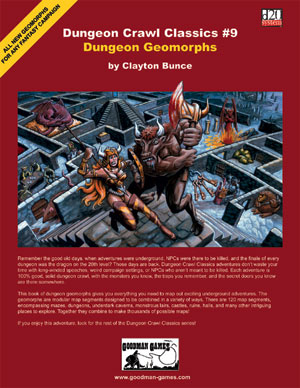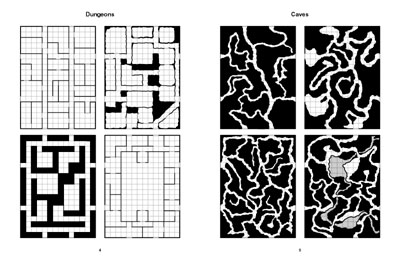| Publisher | Goodman Games |
| Writing Credits | Cartography by Clayton Bunce, Chuck Whelon & Brad McDevitt Editing |
| Art Credits | Graphic design by Joseph Goodman |
| Game Contents | 32 pages, b&w |
| Guidelines | Book of Geomorphic Maps |
| MSRP | $10.99 |
| Reviewer | Andy Vetromile |
Games and geomorphic maps: They just seem to go together. Board games – everything from WizWar to RoboRally – use them to create their playing surfaces, and to some extent the same holds true for roleplaying games. A few adventure modules and supplements over the years have made use of them, but few have made it the product’s raison d’etre. Goodman Games thinks it sees some value in offering just such a selection inDungeon Crawl Classics #9: Dungeon Geomorphs.
As the title suggests, the book contains a series of geomorphic maps. Every page has four such insets, and each has eight connections, two per side, that are the same for all the maps. One segment butts up against another and all the passageways attach at the same spots. They line up best side to side and end to end, but graphically minded folks will find other compositions.
If a tile doesn’t precisely serve your purpose, fuss with the photocopy (kind of a waste just to cut the book up) and make all the changes you need to an individual bit. It’s a simple matter to mark out one exit (or add a wall, or fill in and eliminate a room, etc.) with a thick black marker. Add a few notes in the margins (if your slice-and-dice session leaves any) or put a number in each room keyed to your adventure outline and you’re good to go.
The sections are grouped by subject matter, so to speak, though the distinctions can be argued. There’s a section of caves, for example, another for temples, pages of mazes, and so on. Often the four pieces on one page, especially if there’s a unifying theme like “the castle,” fit together as one larger piece if desired.
Graphically, the supplement is a pretty simple one. There are only three pieces of art to speak of (front and back covers, plus the frontispiece); while the last two are fairly unremarkable the front cover is actually an enjoyable bit of artistic whimsy.
The maps themselves aren’t exactly masterpieces, but they’re expected to serve a pretty utilitarian function. The problem is they may not be all that easy to use. If it’s a GM’s aid, a set of building blocks he uses while designing the adventure, then they’re a good jolt to the creative cells. But can you really drag a loose set of these things to the gaming table like a hand of cards? If you paste them to backing boards and cut them out, they can be easily reused, but that’s a lot of work. If the dungeon isn’t a simple parallel layout (i.e., “three tiles across, four down”), a referee cutting and pasting them together as a map for his own reference may have several tunnel sections spilling about like an awkward octopus.
Are they any use to the players? The players don’t build the dungeon, and the maps are too small for miniatures combat. On the other hand, the book rightly points out that copies can be used to make maps as handouts for the team. Some alterations, or even just ripping the vital corners off the edges, give it that annoying, can’t-quite-read-it treasure map look.
After the “how to use this book” portion, the rest of the book is maps (so that’s 120 segments for those keeping score). The insides of the covers have extra, blank maps that are supposed to let the referee make custom maps, but they used non-photocopy blue ink (or something close) for the images, and that makes anything but the solid edges hard to copy or make out. A shame since in theory the pieces could be enlarged 400% during copying and the maps would then be big enough for the aforementioned miniatures. As it is, even the black and white images that make up the interior suffer the vagaries of current enlargement technology.
For anyone who doesn’t believe there’s still any cachet to having the d20 logo on the cover of their book, talk to Goodman Games. This book has it, even though the interior lacks anything that might be considered D&D specific. Even the introduction is labeled as Open Gaming Content (feel free to use it), but it’s just instruction on using the geomorphs, which are not OGC.
It would be conceited to think every hobbyist out there has a computer, so it may be unfair to suggest this is the sort of thing that would better serve its audience through on-line .pdf files. But the book itself expects consumers will use at least a copying machine, making the inexpensive Dungeon Crawl Classics #9: Dungeon Geomorphs a nice idea that, in practice, has limited utility.

